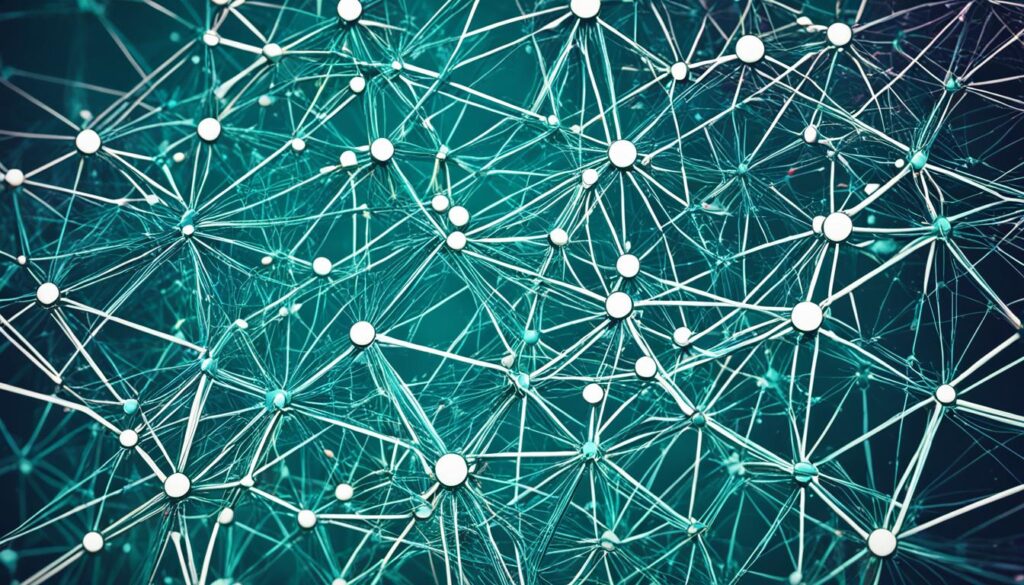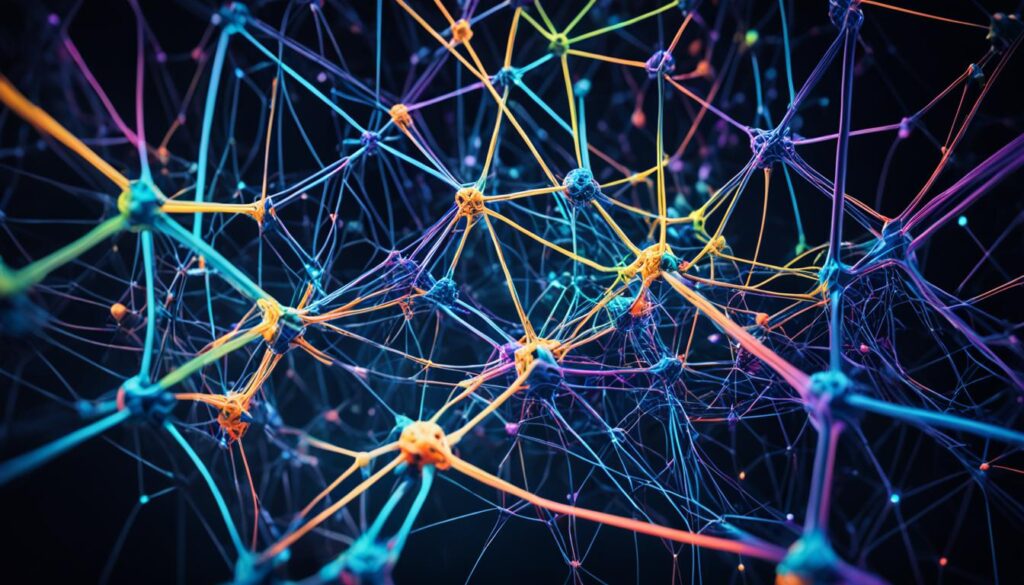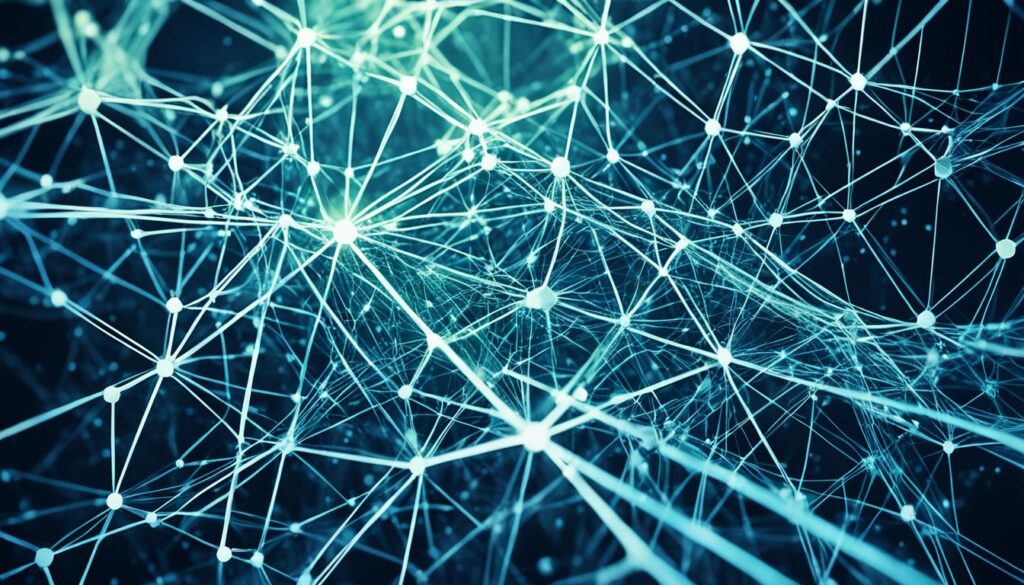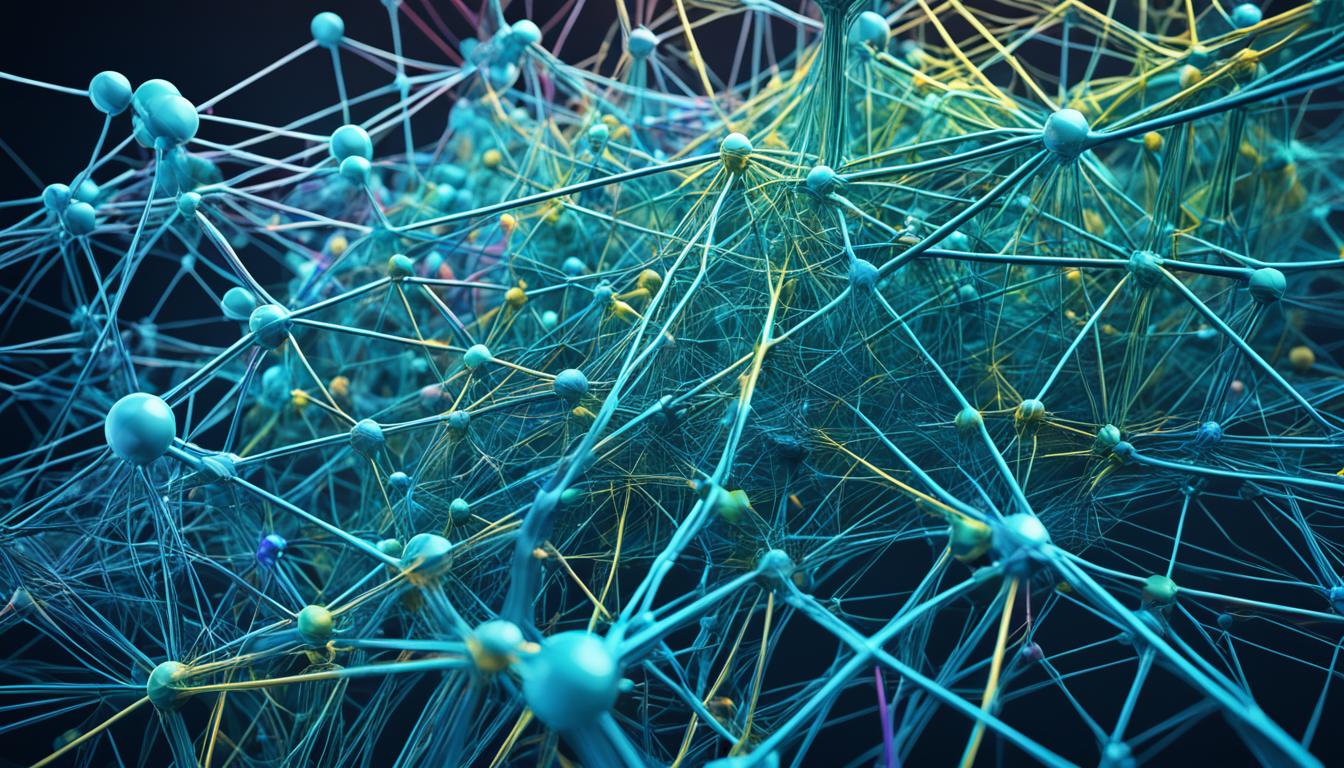Welcome to our deep dive into neural networks, a fundamental concept in the field of deep learning. In this article, we will explore the theory and practical applications of neural networks, a key component of artificial intelligence and machine learning. Whether you’re new to the concept or looking to expand your knowledge, we’ve got you covered.
Neural networks play a crucial role in deep learning, allowing us to train models to recognize patterns and make predictions based on data. They have revolutionized fields like natural language processing (NLP) and computer vision, making complex tasks like image recognition and speech processing possible.
There are various types of neural networks, including feedforward neural networks, convolutional neural networks (CNNs), and recurrent neural networks (RNNs). Each type has its own unique structure and strengths, catering to specific tasks and domains.
Deep learning algorithms, powered by neural network models, have transformed industries like healthcare, finance, marketing, and entertainment. From disease diagnosis to stock price predictions, neural networks are solving complex problems and driving innovation.
Key Takeaways:
- Neural networks are a fundamental concept in deep learning, a subfield of artificial intelligence.
- They are used to recognize patterns and make predictions based on data.
- Different types of neural networks cater to specific tasks, such as image recognition and natural language processing.
- Neural networks have applications in various industries, including healthcare, finance, marketing, and entertainment.
- Understanding neural network theory and practical implementation is crucial for researchers in the field of deep learning.
The Importance of Neural Networks in Deep Learning
Neural networks play a crucial role in the field of deep learning. These powerful algorithms have the ability to learn and recognize complex patterns within vast amounts of data. This makes neural networks highly valuable for a wide range of applications, including image recognition, natural language processing, and speech recognition.
One of the key strengths of neural networks is their capacity to process and analyze large volumes of data. This capability allows them to identify intricate patterns and make accurate predictions based on the input provided. For example, in image recognition, neural networks can identify objects, people, or scenes within images, enabling applications such as autonomous vehicles, facial recognition systems, and medical image analysis.
Furthermore, neural networks have significant applications in natural language processing. They can understand and interpret human language, facilitating tasks such as sentiment analysis, language translation, and chatbot development. In the realm of speech recognition, neural networks can accurately transcribe spoken words, transforming the way we interact with voice assistants, voice-controlled devices, and transcription services.
The versatility of neural networks is evident in the wide range of industries that benefit from their applications. In healthcare, neural networks assist in medical diagnosis, drug discovery, and personalized treatment plans. In finance, they support fraud detection, risk assessment, and stock market prediction. Marketing professionals utilize neural networks for analyzing consumer behavior and optimizing ad targeting strategies. Additionally, the entertainment industry leverages neural networks for content recommendation systems, music and video generation, and virtual reality experiences.

By harnessing the power of neural networks, deep learning enables us to tackle complex problems in various domains. These sophisticated algorithms have revolutionized the way we process and understand data, making significant advancements in artificial intelligence. The applications of neural networks continue to expand as researchers explore new possibilities and push the boundaries of what is achievable.
Understanding Neural Network Structures
Neural networks, the building blocks of deep learning, are composed of interconnected nodes called neurons. These neurons mimic the behavior of biological neurons and play a vital role in processing information. Understanding the structure of neural networks is fundamental in comprehending their functionality and potential.
In a neural network, neurons are organized into layers, each serving a specific purpose in the data processing pipeline. The input layer receives raw data, which is then passed through a series of hidden layers, culminating in an output layer that produces the final result. This layer-wise arrangement enables neural networks to learn complex patterns and make accurate predictions.
The connections between neurons are where the magic happens. These connections, also known as weights, represent the strength and significance of the information flow between neurons. By adjusting the weights, neural networks can adapt and improve over time. This process, called backpropagation, fine-tunes the network’s performance and enhances its ability to handle complex tasks.
Neural networks come in various structures, each tailored to different types of problems. Feedforward networks are the most common type, where data flows in one direction, from the input layer to the output layer. Convolutional networks excel in image recognition tasks by utilizing specialized layers for detecting features and patterns. Recurrent networks possess a feedback mechanism, enabling them to process sequential data and make predictions based on context.
| Network Structure | Key Characteristics |
|---|---|
| Feedforward | Data flows in one direction, ideal for pattern recognition tasks. |
| Convolutional | Specialized layers for image recognition, feature detection, and pattern analysis. |
| Recurrent | Feedback mechanism for processing sequential data and leveraging context. |
Understanding the neural network structure is crucial for researchers and practitioners working with deep learning. By selecting the appropriate network architecture and fine-tuning the connections between neurons, they can harness the power of neural networks to tackle a wide range of complex tasks with precision and accuracy.
Practical Applications of Neural Networks
Neural networks are revolutionizing industries across the board, with their practical applications being particularly noteworthy. Their ability to recognize patterns and make predictions based on data has made them invaluable in various sectors. Let’s explore some key applications of neural networks in different industries:
1. Healthcare
In the field of healthcare, neural networks have proven to be powerful tools for disease diagnosis and personalized treatment. By analyzing medical data, these networks can identify complex patterns and help healthcare professionals make accurate diagnoses. Additionally, neural networks can assist in developing personalized treatment plans based on individual patient data.
2. Finance
In the finance industry, neural networks are used extensively for several tasks. They can predict stock prices with high accuracy by analyzing historical market data and identifying complex trends. Neural networks are also effective in detecting fraudulent activities, helping financial institutions protect themselves and their customers from potential threats.
3. Marketing
Neural networks are transforming the field of marketing. By analyzing customer behavior and preferences, they can provide valuable insights to marketers. This information helps improve the effectiveness of marketing campaigns by identifying the target audience, optimizing advertising strategies, and personalizing customer experiences.
4. Entertainment
Neural networks have made a significant impact on the entertainment industry. Recommendation systems powered by neural networks offer personalized content suggestions to users, enhancing the viewer experience. Moreover, neural networks can generate creative content, such as artwork, music, and even storylines, enabling new possibilities for content creation.
These are just a few examples that demonstrate the versatility and practicality of neural networks. Industries across the board are leveraging the power of deep learning to solve complex problems and drive innovation.

Training and Implementing Neural Networks
To effectively work with neural networks, researchers require practical experience in training and implementing them. Deep learning frameworks like TensorFlow and PyTorch provide libraries and tools that streamline the process of building and training neural networks. However, successful implementation goes beyond just using these frameworks; it involves understanding key concepts and techniques.
Data Preprocessing
Before training a neural network, researchers must preprocess the data to ensure it is in a suitable format. This involves tasks like cleaning and normalizing the data, handling missing values, and encoding categorical variables. Proper data preprocessing enhances the network’s ability to learn and make accurate predictions.
Model Architecture Design
The design of the neural network architecture plays a critical role in its performance. Researchers need to determine the appropriate number and types of layers, as well as the number of neurons in each layer. Experimentation with different architectures helps optimize the performance of the network for a specific task.
Hyperparameter Tuning
Neural networks have hyperparameters that control the learning process, such as learning rate, batch size, and regularization strength. Tuning these hyperparameters is essential to optimize the network’s performance. Researchers can use techniques like grid search or random search to find the best combination of hyperparameters.
Implementing and training neural networks requires a combination of theoretical knowledge and hands-on experience with deep learning frameworks such as TensorFlow and PyTorch. Researchers must be proficient in coding and have a solid understanding of the underlying concepts to ensure successful implementation.
Below is a summary table comparing TensorFlow and PyTorch, two popular deep learning frameworks:
| Framework | Advantages | Disadvantages |
|---|---|---|
| TensorFlow | – Large and active community – Scalability – Deployment in production |
– Steeper learning curve – Complex debugging |
| PyTorch | – Pythonic syntax – Dynamic computation graph – Easy debugging |
– Limited deployment options – Smaller community compared to TensorFlow |
Note: The above table provides a high-level comparison and each framework has its own strengths and weaknesses based on specific use cases.

By gaining practical experience in training and implementing neural networks, researchers can unlock the true potential of deep learning. Understanding data preprocessing, model architecture design, and hyperparameter tuning are key components in developing effective and efficient neural network models.
Advancements and Future Opportunities in Neural Networks
Neural networks have come a long way in the field of deep learning, and the constant advancements in this domain continue to push the boundaries of what is possible. Researchers are constantly exploring new techniques and algorithms to improve the performance and efficiency of neural networks. The future of neural networks holds exciting opportunities for advancements in various domains, including natural language processing, computer vision, and more.
One area where neural networks have shown tremendous progress is in natural language processing (NLP). These advancements have enabled machines to understand and generate human-like language, opening doors to applications such as chatbots, language translation, and sentiment analysis. Neural networks have also revolutionized computer vision, allowing machines to recognize objects, detect and track movement, and even analyze facial expressions.
“Advancements in NLP and computer vision have significantly enhanced the capabilities of neural networks, paving the way for more innovative applications,” says Dr. Emily Johnson, a leading researcher in deep learning at Stanford University.
“The ability of neural networks to process and analyze vast amounts of data is fueling groundbreaking developments in a wide range of industries,” adds Dr. Johnson.
The future opportunities in neural networks are vast and promising. As technology continues to advance, we can expect to see further breakthroughs in areas such as healthcare, finance, cybersecurity, and autonomous systems. Neural networks have the potential to enhance medical diagnosis, predict diseases, and personalize treatment plans. They can help financial institutions identify patterns and trends, making smarter decisions in investment and risk management. Moreover, neural networks are essential in creating robust cybersecurity systems that can detect and prevent online threats.
To provide a comprehensive overview of the advancements and future opportunities in neural networks, the following table illustrates some key developments and their potential applications:
| Advancements | Potential Applications |
|---|---|
| Recurrent Neural Networks (RNNs) | Natural language processing, speech recognition, and generating sequence-based predictions. |
| Generative Adversarial Networks (GANs) | Creating realistic images, video synthesis, and producing artificial content. |
| Transformers | Improving machine translation, language modeling, and document summarization. |
| Graph Neural Networks (GNNs) | Analyzing social networks, recommendation systems, and identifying relationships in graph data. |

As we delve deeper into the realms of neural networks and deep learning, it becomes evident that the advancements and future opportunities in this field are immense. Staying updated with the latest research and developments is paramount for researchers in deep learning, as it not only broadens their knowledge but also fuels innovation across industries.
Conclusion
Neural networks are an essential component of deep learning, playing a crucial role in the field of artificial intelligence. Researchers in this domain must possess a solid understanding of neural network theory and practical experience in training and implementing models. Mastery of both these aspects is necessary to leverage the potential of neural networks for various applications.
For researchers seeking assistance in their academic writing and research endeavors, WriteBing.com offers academic writing services that can streamline the research process and effectively communicate research findings. Whether it’s producing scholarly articles, research papers, or thesis writing, WriteBing.com can provide valuable support in developing well-structured and insightful content.
Staying updated with the latest advancements and future opportunities in neural networks is paramount for researchers in deep learning. As the field continues to evolve rapidly, being on top of emerging techniques and algorithms can give researchers a competitive edge. By remaining proactive and adapting to the ever-changing landscape of neural networks, researchers can push the boundaries of what is possible in artificial intelligence.
FAQ
What are neural networks?
Neural networks are a fundamental concept in deep learning, a subfield of artificial intelligence. They involve training models to recognize patterns and make predictions based on data. Neural networks consist of interconnected nodes called neurons arranged in layers. These neurons simulate the behavior of biological neurons and use mathematical functions to process input data and generate output.
What are the different types of neural networks?
There are different types of neural networks, such as feedforward neural networks, convolutional neural networks, and recurrent neural networks. Each network structure has different strengths and weaknesses, making them suitable for specific tasks.
What are the practical applications of neural networks?
Neural networks have applications in various industries, including healthcare, finance, marketing, and entertainment. They can be used for tasks such as disease diagnosis, personalized treatment, predicting stock prices, detecting fraudulent activities, analyzing customer behavior, optimizing marketing campaigns, recommendation systems, and content generation.
How can I train and implement neural networks?
To effectively work with neural networks, researchers need practical experience in training and implementing them. Deep learning frameworks like TensorFlow and PyTorch provide libraries and tools for building and training neural networks. Researchers must understand the concepts of data preprocessing, model architecture design, and hyperparameter tuning.
What are the advancements and future opportunities in neural networks?
Neural networks are constantly evolving, and advancements in deep learning continue to push the boundaries of what is possible. Researchers are exploring new techniques and algorithms to improve network performance and efficiency. Future opportunities in neural networks include advancements in natural language processing, computer vision, and other domains.
How does understanding neural networks benefit researchers in deep learning?
Understanding the theory and practical applications of neural networks is crucial for researchers in deep learning. Neural networks are a fundamental component of deep learning and have wide-ranging applications in artificial intelligence. Researchers need a solid understanding of neural network theory and practical experience in training and implementing models.
How can academic writing services assist with neural network research?
Academic writing services like WriteBing.com can help streamline the research process and effectively communicate research findings. They can assist researchers in deep learning by providing writing services that accurately convey the knowledge and insights gained from studying neural networks.








